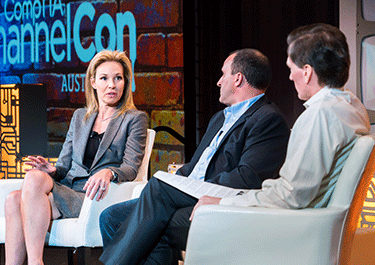 Alyssa Fitzpatrick, general manager of worldwide channel sales for Microsoft, answered questions about the software giant’s new “partner first” strategy during a keynote interview with CompTIA CEO Todd Thibodeaux and ChannelE2E Editor Joe Panettieri at ChannelCon 2017. The conversation with Fitzpatrick is timely, coming just days after the groundbreaking initiative was announced at the Microsoft Partner Conference in mid-July.
Alyssa Fitzpatrick, general manager of worldwide channel sales for Microsoft, answered questions about the software giant’s new “partner first” strategy during a keynote interview with CompTIA CEO Todd Thibodeaux and ChannelE2E Editor Joe Panettieri at ChannelCon 2017. The conversation with Fitzpatrick is timely, coming just days after the groundbreaking initiative was announced at the Microsoft Partner Conference in mid-July.
“We’ve always been a partner-led company,” Fitzpatrick said. “That was the foundation of our early roots and early days, but we are transforming ourselves to be ‘partner first.’ What that means is we’re actually putting the partners’ success first in front of what we are doing from a measurement, metrics and management perspective.”
Effective July 1, the new channel go-to-market model was a year in the making and Fitzpatrick said it’s ready today. “The model is here. It’s now. It’s happening,” she said.
With the new model, Microsoft has transformed how it works with partners with an eye toward simplifying the experience, she said. To that end, it consolidated more than 150 partner programs down to one commercial partner program. That, in turn, has enabled Microsoft to adopt best practices from across these programs to fine-tune how it works with partners, Fitzpatrick said.
And, she added, it’s eliminated duplicate efforts. “We weren’t working together. We were doing double work,” she said, noting a smarter approach. “We could stack our skill-sets, our work effort instead of working in parallel.”
Another significant change is in partner engagement and support. “We are actually separating the individual teams that work with our partners [and] that build solutions with our partners from the teams that are selling,” Fitzpatrick said, noting the selling teams will be local.
In practice, this means that partners will no longer work with only one Microsoft person but a team of people. “You get technical resources. You get partner managers that are going to help build with you. And, then you get sellers all around the globe that will sell solutions together with you in a co-sell motion,” she said.
A significant signal of Microsoft’s partner-first approach is that it will compensate its internal co-selling teams in the same way it does its partners, which is on consumption. “That is an absolute change in the way we’ve operated and it’s a much more partner-friendly,” Fitzpatrick said, noting that it is designed to reduce channel conflict.
In addition, Microsoft is changing how it’s packaging solutions for partners, beginning with Microsoft365. Not to be confused with Office365, Microsoft365 is a bundle that includes Office 365, Windows 10, enterprise mobility and security in combinations for enterprise or small- to medium-sized businesses.
Microsoft is also creating vertical solutions in six industries – manufacturing, health care, financial, retail, education and government – where Fitzpatrick noted there is a “rich opportunity for modernization.”
Similarly, she said the company has simplified its portfolio around four suites:
- Modern workplace (e.g., Office 365).
- Business applications (e.g., Dynamics CRM).
- Core applications and infrastructure (e.g., Azure).
- Data and artificial intelligence (e.g., IoT and emerging technologies).
Fitzpatrick acknowledged these are big changes for Microsoft’s internal teams and its partner ecosystem. But she is bullish on opportunities it will enable for partners to more easily work with their customers on their journey to the cloud in a coordinated, stair-step manner.
“I do think there is a great opportunity for us to move our customers to the cloud when they are ready,” Fitzpatrick said. “I really believe in the hybrid approach, giving the customer an opportunity to sample a workload in the cloud.”
That said, she also offered would-be cloud partners some key advice:
- Make sure you have the skill-set in house to be able to handle cloud projects.
- Listen to your customers. Let them guide you as to their needs and comfort with change.
- Help your customers understand that digital transformation is going to give them an accelerant to their business model.

